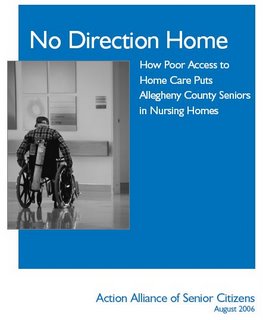How Does It Feel . . . With No Direction Home?
Once upon a time you dressed so fine.
You threw the bums a dime in your prime, didn't you?
People'd call, say, "Beware doll, you're bound to fall"
You thought they were all kiddin' you.
You used to laugh about
Everybody that was hangin' out.
Now you don't talk so loud,
Now you don't seem so proud,
About having to be scrounging for your next meal.
How does it feel? . . .
You threw the bums a dime in your prime, didn't you?
People'd call, say, "Beware doll, you're bound to fall"
You thought they were all kiddin' you.
You used to laugh about
Everybody that was hangin' out.
Now you don't talk so loud,
Now you don't seem so proud,
About having to be scrounging for your next meal.
How does it feel? . . .
On October 18, 2006, the Philadelphia Inquirer published a news article, by Michael Vitez, entitled "Report Faults PA's Senior Care", found online here. The article notes a report released in August, 2006, by the Action Alliance of Senior Citizens and the Service Employees International Union, entitled "No Direction Home: How Poor Access to Home Care Puts Allegheny County Seniors in Nursing Homes" (31 pp.).
This Report began with its conclusion: "Pennsylvania is the second-oldest state in the nation, but ranks among the worst states for providing senior citizens with access to home care." The Report's "Executive Summary" then continues:
Most seniors who need long term care in the Commonwealth end up living in nursing homes, despite the significant cost savings of home care, and polling that shows the vast majority of Pennsylvanians would prefer to receive care at home instead.
Those who do receive home care report problems finding and keeping qualified caregivers due to high turnover. The turnover is fueled by poverty-level wages and a lack of benefits such as health care coverage, sick days, and vacation time for caregivers.
Pennsylvania's senior population is growing rapidly, so our elected leaders should take steps now to improve access to home care and build the stable, professional care-giving workforce that will be needed to meet the growing need for home care before it becomes a major crisis.
The organizations releasing the Report appear from their websites to be pro-labor, and so offer a different perspective on the problem of long-term care in seniors' homes. The article draws attention to portions of the Report focusing on workers who provide seniors with personal care in a home setting:
Those who do receive home care report problems finding and keeping qualified caregivers," the report said, noting that 40 percent of home health workers have been with their employer less than one year.The PA Department of Aging maintains a web page regarding long-term care. The Department states: "In recent years, more and more people are choosing to stay in their homes and arrangements are being made for the care and services to come to them."
"The turnover is fueled by poverty-level wages and a lack of benefits such as health-care coverage, sick days, and vacation for caregivers," it said.
"The pay is bad, the working conditions are bad, the protections are bad, and they have no medical benefits," said Pedro Rodriquez, president of Action Alliance. "And seniors can identify. They want the person taking care of them to be taken care of as well."
The report also said that in 2004, Pennsylvania spent nearly three times more on nursing homes than on home care.
On its web page devoted to Long-Term Care "In Your Home", the Department says:
"In general, you have the greatest independence in your home and that is where you may prefer to stay. You don’t have to move from your home or apartment to get most long term care and services. Most home health care agencies, homemaker service companies, physical therapists, etc., will make arrangements to visit your home to provide them."The article reports the Department's assertion that "the administration funded 2,800 more people in home and community care . . . [and it] also provided funding for 1,500 people with disabilities to receive care at home."
Yet the Report remains critical of long-term home care in Pennsylvania, stating:
- 80,000 Pennsylvanians are in nursing homes, 54,000 of them paid for with money from taxpayers.
- Fewer than 15,000 Medicaid recipients get home care.
- By 2020, 18.8 percent of Pennsylvanians are expected to be older than 65, an increase of half a million since 2000.
- The over-85 population is expected grow by 52 percent.
- There is a shortage of about 10,000 direct-care workers.
How does it feel?
To be on your own,
With no direction home,
Like a complete unknown,
Like a rolling stone?
-- Bob Dylan, "Like a Rolling Stone"
To be on your own,
With no direction home,
Like a complete unknown,
Like a rolling stone?
-- Bob Dylan, "Like a Rolling Stone"
(Copyright © 1965; Renewed 1993 - Special Rider Music)




